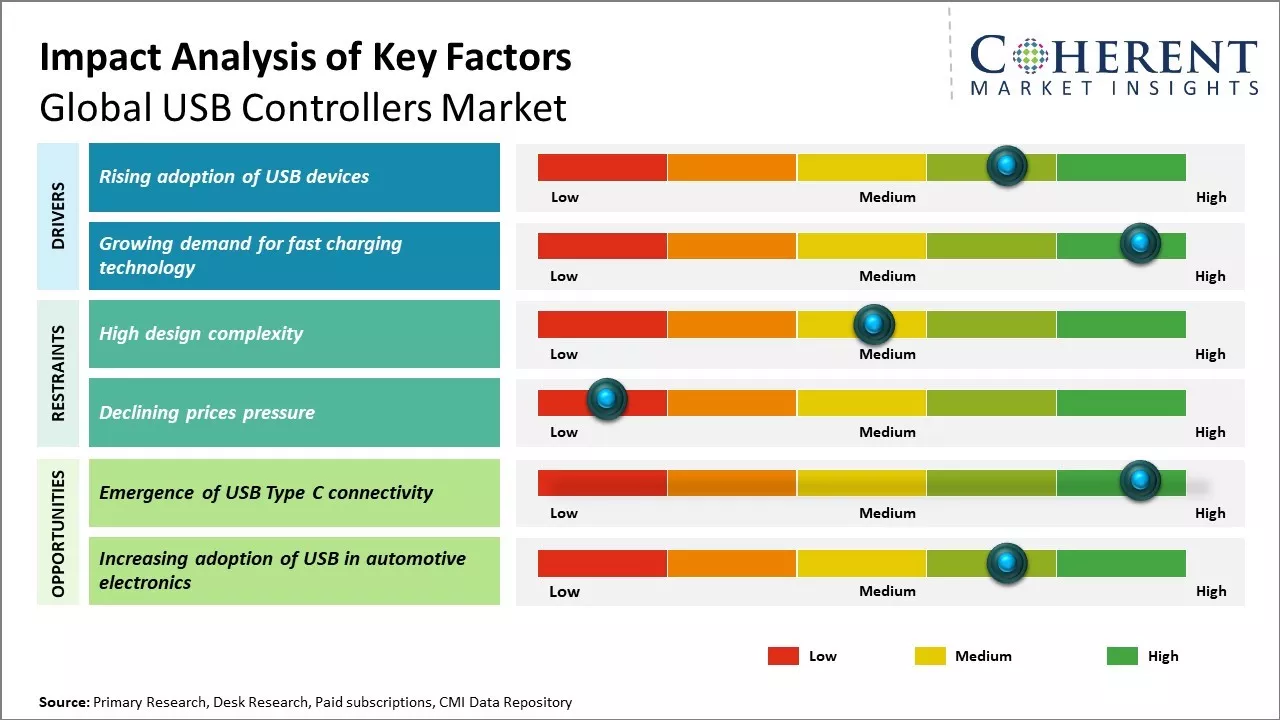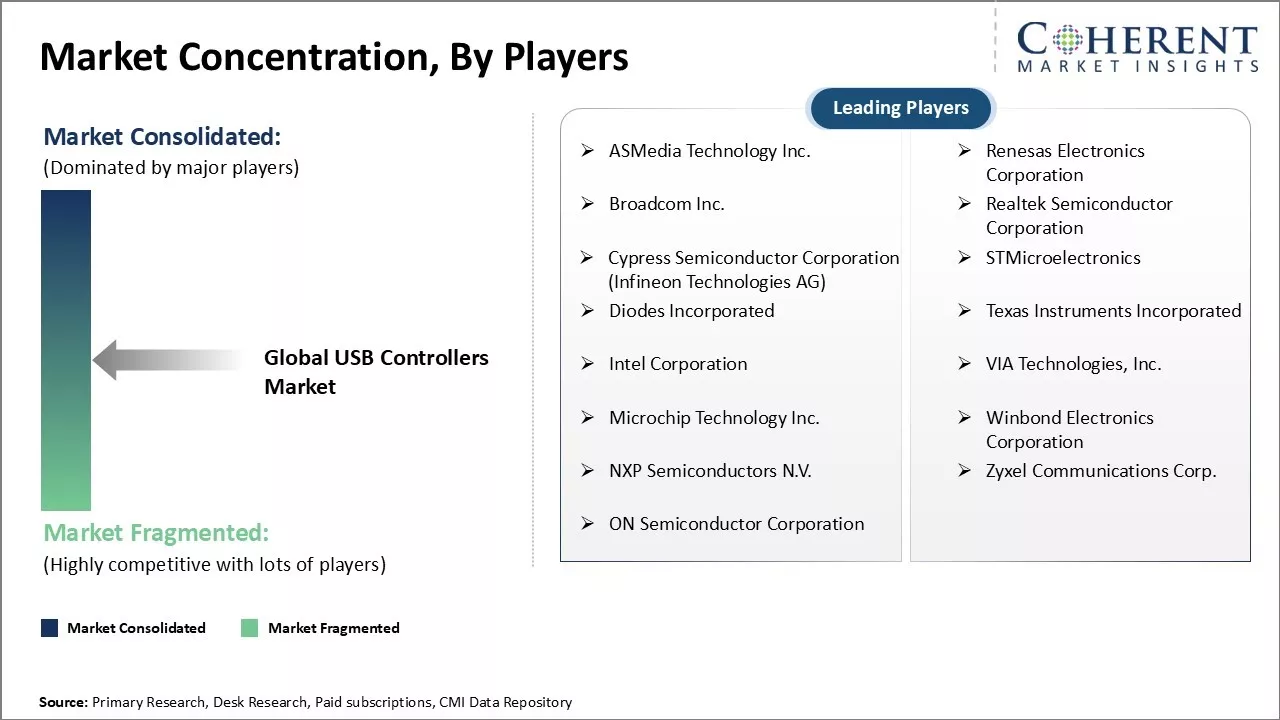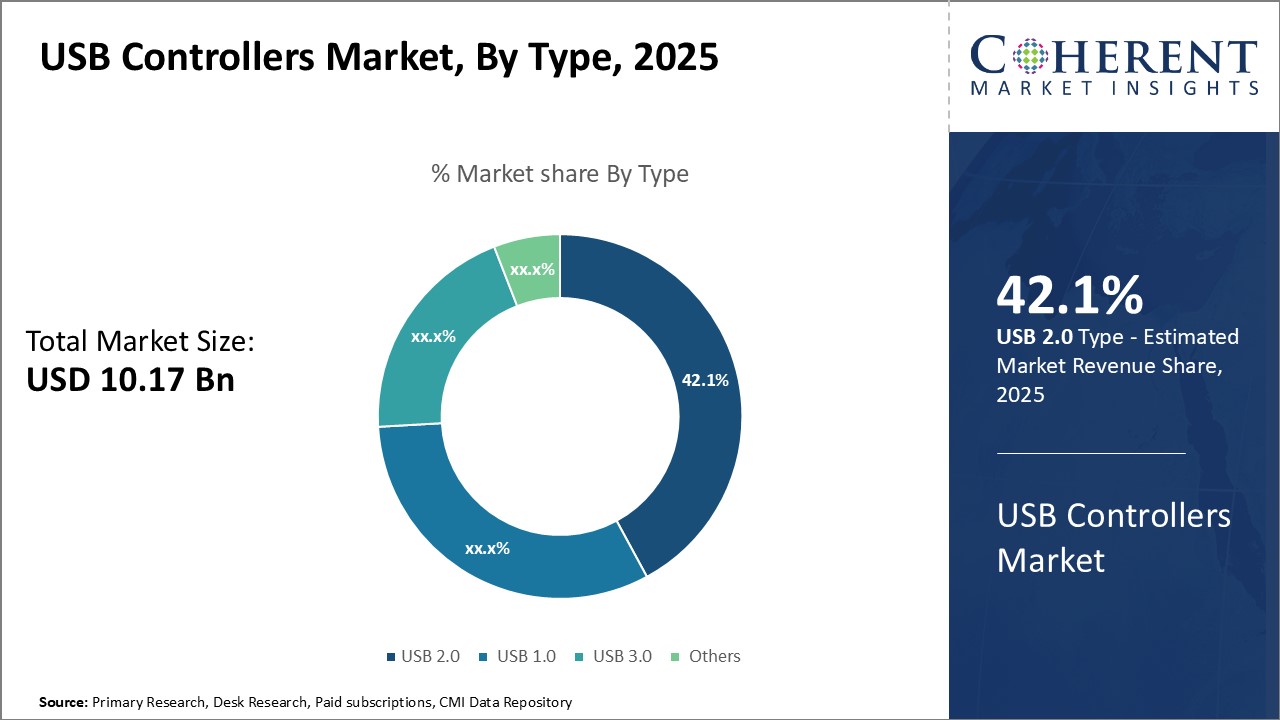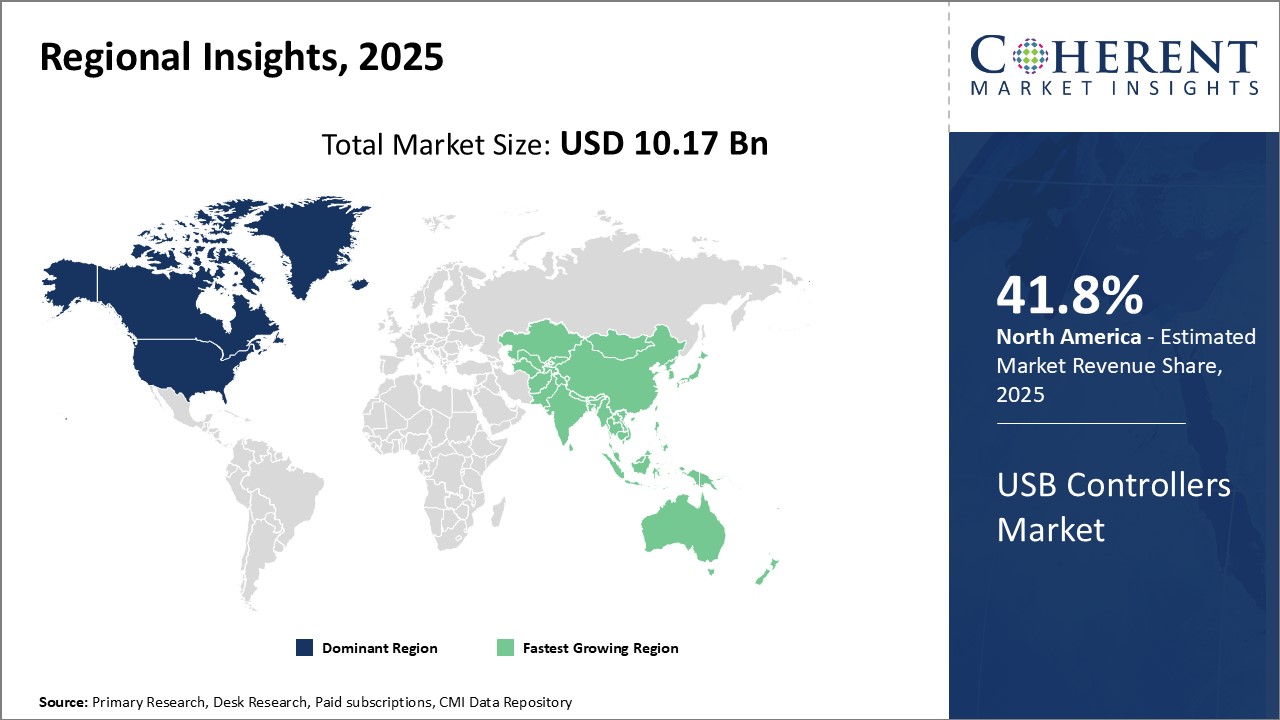USB Controllers Market Size and Trends
The Global USB Controllers Market is estimated to be valued at US$ 10.17 Bn in 2025 and is expected to reach US$ 19.97 Bn by 2032, exhibiting a compound annual growth rate (CAGR) of 10.1% from 2025 to 2032.

Discover market dynamics shaping the industry: Download Free Sample
Widespread adoption of smart computing devices and the rising demand for the integration of USB Type C ports in smartphones and tablets are driving the growth of the USB controllers market. Additionally, the increasing demand for high-speed connectivity solutions across various industry verticals including consumer electronics, IT and telecommunication, transportation, and industrial is further propelling the demand for USB controllers. Also, the emerging trends of connected devices and Bring Your Own Device (BYOD) is fuelling the need for advanced USB solutions. The development of advanced USB3.2 and USB4 standards promising faster data transfer capabilities is anticipated to offer lucrative opportunities for vendors operating in the USB controllers market in the coming years.
Rising adoption of USB devices
With technology advancing at an ever increasing pace, newer and more advanced devices are being developed which require faster and more robust connectivity solutions. USB has emerged as one of the most popular and universal ports for connecting a wide variety of peripheral devices such as smartphones, tablets, laptops, gaming consoles, cameras, and more to each other and to computers. Its versatility and compatibility with a massive ecosystem of devices has made USB the interface of choice for various applications.
The proliferation of USB powered devices across industries has largely been driven by the increasing digitization of work processes and personal lives. More organizations are relying on digital tools and technologies to improve productivity, make work processes seamless and data-driven. This has boosted the demand for high-speed external storage devices, projectors, printers, and other USB connected devices in office environments.
When it comes to consumers, advanced USB devices like virtual and augmented reality headsets, wireless portable speakers, drones, and smart home appliances offer innovative interactive and personalized experiences. As their capabilities continue to rise and prices drop, their market is expanding exponentially. The rapid rise of mobile computing has also expanded the role of USB with smartphones and tablets fully embracing the connectivity standard to enable file transfers, expand storage capacities and connect to a range of peripherals using USB-C ports. All these dynamics are creating a massive need for high performance USB controllers that can support growing USB device loads seamlessly and at optimum speeds.
Market Concentration and Competitive Landscape

Get actionable strategies to beat competition: Download Free Sample
Growing demand for fast charging technology
With each new generation, battery capacities of portable electronic devices have increased while their sizes have decreased, pushing for faster ways to charge these devices. Rapid charging has emerged as a necessity rather than luxury to boost depleted batteries in the shortest time possible. This is driving strong interest in USB controllers that support quick and fast charging protocols.
The current Li-ion battery technology unfortunately permits only a limited number of charge cycles before capacity starts degrading. Consequently, the ability to quickly replenish power has become the need of the hour. On the go professionals, students, and customers alike want their phones, tablets, and laptops to be ready with ample juice within a short charging window whenever required. Moreover, the rise of resource-intensive applications and higher resolution displays have significantly increased power consumption rates of mobile devices.
Key Takeaways from Analyst:
The rapid adoption of USB devices across various applications including PCs, smartphones, gaming consoles, and more will be a major growth driver. As USB continues to be the most widely used connectivity protocol, the demand for USB controllers to support these connected devices will continue to rise. The proliferation of USB Type-C and the upcoming USB 4.0 standard that promises faster data transfer speeds will open up new opportunities for controllers supporting the latest technologies.
North America currently dominates the USB controllers market owing to strong demand from various end-use verticals. However, Asia Pacific is expected to witness the fastest growth over the forecast period. This can be attributed to the expansion of electronics manufacturing hubs in countries like China and the growing adoption of mobile computing devices in emerging economies of the region.
Meanwhile, compatibility issues between devices and controllers when new USB standards are launched could act as a potential restraint. Also, the availability of alternate connectivity options like Thunderbolt may challenge the growth prospects to some extent over the long term. To counter such restraints, market players must focus on timely launching of USB controller solutions compliant with evolving industry standards. They should also diversify their product portfolios to address requirements across multiple USB generations.
Market Challenges: High design complexity
The increasingly complex design of USB controller chips is posing a major challenge for the growth of the global USB controllers market. As USB standards continue to evolve with new specifications focused on higher speeds and more advanced functionality, the internal architecture and silicon design of USB controller ICs is becoming exponentially more complicated.
USB 4.0 for example has doubled the maximum permitted bandwidth to 40Gbps while maintaining compatibility with previous standards. Achieving such high data throughput within the size and power constraints of portable electronics requires extremely sophisticated semiconductor design with many logic gates, circuits and engineering trade-offs. For chipmakers, developing USB controllers that can support the latest specifications like USB 4.0 entails expending considerable resources in R&D. This steep rise in design requirements is lengthening product development cycles and increasing per unit manufacturing costs.
The greater complexity is also making USB controllers more prone to design bugs and flaws. Advanced FinFET process technologies that offer more transistors per chip area are ironically harder to design for. This has led to lower initial chip yields for manufacturers. Issues found during compliance testing cause costly re-spins that further delay product launches. Some USB controller models may need to go through multiple revisions before achieving the expected level of reliability. These reliability issues damage the reputation of controllers and slow overall market acceptance of new USB standards.
Market Opportunities: Emergence of USB Type C connectivity
The emergence of USB Type C connectivity represents a major opportunity for growth in the global USB controllers market. USB Type C offers several advantages over older USB port types that are driving its widespread adoption. USB Type C connectors are reversible and allow for faster charging and data transfer speeds. They can also support newer technologies like Display Port and power delivery. This widespread adoption of USB Type C is causing increased demand for USB controllers that are compatible with the newer standard.
As USB Type C starts appearing on more device types from smartphones to laptops to accessories, chipmakers see a need to design controllers that fully support the latest capabilities and power levels of USB Type C. The addition of USB Type C ports to devices requires an updated USB controller that can recognize the Type C connector, negotiate bus protocols and power levels, and switch to the appropriate mode of operation. Manufacturers are racing to release newer generations of USB controllers with expanded USB Type C compliance and features in order to capitalize on the growing base of compatible devices.

Discover high revenue pocket segments and roadmap to it: Download Free Sample
Insights By Type - Ease of Use & Backward Compatibility Boosts USB 2.0 Demand
In terms of type, the USB 2.0 segment is expected to hold 42.1% share of the market in 2025 owing to its widespread adoption and compatibility. USB 2.0 struck a perfect balance between speed and universality, making it the standard for years. Its data transfer rate of 480Mbps meets the needs of most consumer applications without the cost and complexity of newer protocols. More importantly, USB 2.0 devices remain compatible with older USB 1.1 and USB 1.0 ports, providing a seamless experience across systems. This backward compatibility gave USB 2.0 lasting popularity among consumers who do not need to upgrade for newer capabilities.
Manufacturers also favor USB 2.0 as it eliminates the need for multiple device options. A single USB 2.0 model can serve older markets while meeting mainstream demands. Additionally, the mature USB 2.0 specification simplified manufacturing processes and reduced per unit costs compared to newer standards. These economic factors encouraged continued USB 2.0 production to address the needs of price-sensitive consumers in developing markets. While technologies advance, USB 2.0 fulfills basic functionality for many use cases. Its user-friendly interface and extensive hardware support cement its role as the entry-level connectivity standard for the foreseeable future.
Insights By Connectivity - Wired Connectivity Ensures Stability for Demanding Applications
In terms of connectivity, the wired segment is expected to hold 53.1% share in 2025 as they underpin applications with stringent latency, throughput or security requirements. USB remains a predominantly wired standard due to its hardwired nature delivering supreme speed, reliability and deterministic performance. Wired USB excels in bandwidth-intensive tasks like transferring bulk multimedia files, HD video playback or syncing large databases. It enables high-speed external storage systems, docking stations and charging ports that depend on steady, guaranteed throughput.
Many industrial and commercial applications also depend on wired USB for mission-critical functions. From POS systems and heavy machinery to digital signage, medical instruments and factory automation – wired connectivity alleviates concerns around signal interference, latency or potential security vulnerabilities of wireless modes. Manufacturing environments with strict process workflows rely on wired USB for uninterrupted data exchange. Devices like barcode scanners, RFID readers directly linked to ERP systems benefit from the immediacy of wired data transfer. As 5G and high-speed wireless continue advancing, wired USB will retain an important role supporting uses that cannot tolerate errors due to signal noise or intermittent connectivity issues. Its resilience and determinism make wired the preferred mode for high-performance, industrial grade applications.
Insights By Application - Expanding Features Drive USB Adoption in Consumer Electronics
Within application segments, the consumer electronics is expected to hold 40.8% share in 2025 USB controller demand driven by intensifying requirements from various connected consumer products. PCs, laptops, mobile phones and tablets rely heavily on USB for expandable storage, fast charging and interfacing with peripheral devices. Newer form factors with minimal ports further boost the utility of USB as a universal I/O interface.
Consumer electronics is also where much of the technological innovation occurs around USB. Devices now commonly feature USB 3.0/3.1 Gen 2 capabilities for speeds up to 10Gbps to quickly transfer HD/4K videos and large files. Products tout 'SuperSpeed USB' branding to lure consumers with faster charging and data rates versus microUSB predecessors. Advancing display technologies also spur the need for high-power USB-C/Thunderbolt 3 to rapidly charge power-hungry devices or connect to external graphics processing units.
Automotive infotainment systems and notebooks likewise gain USB Type-C/Thunderbolt integration to deliver video/data to docks or connect high-resolution monitors. As applications complexify, demand rises for more robust and multifunctional USB controllers equipped with features like external display support, Power Delivery for faster validation and alternate modes. Consumer electronics manufacturers will drive additional innovation as they seek novel ways to enhance end-user experiences through inventive USB solutions.
Regional Insights

Need a Different Region or Segment? Download Free Sample
North America has established itself as the dominant region in the global USB controllers market. The region is expected to account for 41.8% of the market share in 2025. The presence of key technology companies and chipset manufacturers in the region has created a robust electronics and peripherals industry. Countries like the US and Canada have spearheaded R&D in chip design and advanced electronics. This has given North American firms an edge in developing cutting-edge USB controller technologies.
Additionally, North America has also been at the forefront of adopting latest computing devices and electronics. High disposable incomes and technology savvy population have fueled consumer demand for devices requiring latest USB standards for faster transfers and improved connectivity. Leading original equipment manufacturers (OEMs) have therefore preferred sourcing controllers from North American suppliers to meet regional compliance and performance expectations. Several OEMs have also established manufacturing and assembly units in North America to cater to strong local demand.
Asia Pacific has emerged as the fastest growing region in the global USB controllers market over the past few years. Massive industrialization and a broadening middle-class in countries like China and India has accelerated uptake of desktops, laptops, smartphones and other electronics. Both consumers as well as enterprises are constantly upgrading to devices with new USB specifications. This bodes well for future uptake of advanced USB controllers in the region.
Countries like China, Japan and South Korea are also emerging as key manufacturing hubs with a growing electronics export base. Local USB controller makers are tapping into this opportunity by aligning their offerings as per requirements of global clients. Favorable policy support and cheaper manufacturing costs have encouraged international firms to set up sourcing units as well. This is cementing Asia Pacific's position as the leading sourcing destination for USB devices and will strengthen control suppliers' market access over the coming years.
Market Report Scope
USB Controllers Market Report Coverage
| Report Coverage | Details | ||
|---|---|---|---|
| Base Year: | 2024 | Market Size in 2025: | USD 10.17 Bn |
| Historical Data for: | 2020 To 2024 | Forecast Period: | 2025 To 2032 |
| Forecast Period 2025 to 2032 CAGR: | 10.1% | 2032 Value Projection: | USD 19.97 Bn |
| Geographies covered: |
|
||
| Segments covered: |
|
||
| Companies covered: |
ASMedia Technology Inc., Broadcom Inc., Cypress Semiconductor Corporation (Infineon Technologies AG), Diodes Incorporated, Intel Corporation, Microchip Technology Inc., NXP Semiconductors N.V., ON Semiconductor Corporation, Renesas Electronics Corporation, Realtek Semiconductor Corporation, STMicroelectronics, Texas Instruments Incorporated, VIA Technologies, Inc., Winbond Electronics Corporation, and Zyxel Communications Corp. |
||
| Growth Drivers: |
|
||
| Restraints & Challenges: |
|
||
Uncover macros and micros vetted on 75+ parameters: Get instant access to report
USB Controllers Industry News
- In November 2023, Infineon Technologies AG, a leading provider of semiconductor solutions, introduced the EZ-USB FX10, the latest addition to its family of programmable USB peripheral controllers. This device offers fast connectivity with USB 10 Gbps and LVDS interfaces, increasing the total bandwidth up to three times compared to its predecessor.
- In November 2023, STMicroelectronics, a global semiconductor leader serving customers across the spectrum of electronics applications, introduced two new USB Type-C-certified port-controller ICs with built-in protection. These solutions help designers implement interfaces cost-effectively to support their required blend of USB features, including power negotiation, managed active cables, and support for guest protocols.
*Definition: The Global USB Controllers Market consists of companies that design and manufacture integrated circuits and circuit boards that connect USB devices to a host device like a computer. USB controllers allow USB devices like keyboards, mice, printers, external storage drives and other peripherals to communicate with and transfer data to and from the host system. They handle all the low level protocol and signaling between USB devices and hosts, freeing up the host processor for other tasks.
Market Segmentation
- Type Insights (Revenue, US$ Bn, 2020 - 2032)
- USB 1.0
- USB 2.0
- USB 3.0
- Others
- Connectivity Insights (Revenue, US$ Bn, 2020 - 2032)
- Wired
- Wireless
- Application Insights (Revenue, US$ Bn, 2020 - 2032)
- Consumer Electronics
- IT & Telecommunication
- Automotive
- Healthcare & Medical Devices
- Others
- Regional Insights (Revenue, US$ Bn, 2020 - 2032)
- North America
- U.S.
- Canada
- Latin America
- Brazil
- Argentina
- Mexico
- Rest of Latin America
- Europe
- Germany
- U.K.
- Spain
- France
- Italy
- Russia
- Rest of Europe
- Asia Pacific
- China
- India
- Japan
- Australia
- South Korea
- ASEAN
- Rest of Asia Pacific
- Middle East & Africa
- GCC Countries
- Israel
- South Africa
- Rest of Middle East & Africa
- North America
- Key Players Insights
- ASMedia Technology Inc.
- Broadcom Inc.
- Cypress Semiconductor Corporation (Infineon Technologies AG)
- Diodes Incorporated
- Intel Corporation
- Microchip Technology Inc.
- NXP Semiconductors N.V.
- ON Semiconductor Corporation
- Renesas Electronics Corporation
- Realtek Semiconductor Corporation
- STMicroelectronics
- Texas Instruments Incorporated
- VIA Technologies, Inc.
- Winbond Electronics Corporation
- Zyxel Communications Corp.
Share
Share
About Author
Ankur Rai is a Research Consultant with over 5 years of experience in handling consulting and syndicated reports across diverse sectors. He manages consulting and market research projects centered on go-to-market strategy, opportunity analysis, competitive landscape, and market size estimation and forecasting. He also advises clients on identifying and targeting absolute opportunities to penetrate untapped markets.
Missing comfort of reading report in your local language? Find your preferred language :
Transform your Strategy with Exclusive Trending Reports :
Frequently Asked Questions
EXISTING CLIENTELE
Joining thousands of companies around the world committed to making the Excellent Business Solutions.
View All Our Clients
